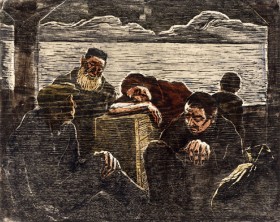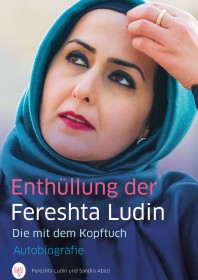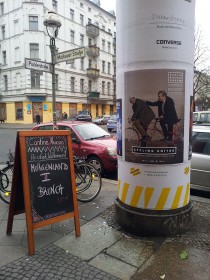An Internet Harvest for the Day of the Refugee

“Refugees”, color woodcut by Jakob Steinhardt, 1946, purchased with funds provided by Stiftung DKLB. You can find this and other related objects in our German-language collection database.
This year’s Day of the Refugee takes place today, 2 October 2015 as part of Intercultural Week, with the slogan “Refugees Welcome!” We have taken this as an occasion to go through our own and other websites and blogs, gathering items on this subject. Since we work at a Jewish museum, stories about fleeing are part of our ‘everyday business’: practically all of the family collections given to our museum tell stories of persecution and flight, going beyond mere statistics to depict the fates of individuals. Letters, travel documents, photographs, and personal memorabilia tell of the desperate search for a country to emigrate to, failed or successful emigrations, the often difficult life in a foreign country, the search for relatives, friends, and former neighbors, now scattered across the entire world. We tell these stories in our permanent exhibition and they have also been the subject of various special exhibitions. At the moment, for instance, in our current cabinet exhibition “In a Foreign Country” you can see publications that originated in Jewish Displaced Persons Camps. Jewish men and women waited there for their passage to Palestine or later Israel, to the USA and other countries, where they hoped to start a new life after the Shoah.
In addition to our exhibitions, we also make stories of flight and displacement visible online, for example with a selection of objects: → continue reading
A Conversation with Fereshta Ludin about the Headscarf Debate, Discrimination, and Her Hopes for the Future.
To win the right to work as a teacher in the classroom while wearing her headscarf, Fereshta Ludin had to go all the way to the German Supreme Court (see below). On 17 September 2015, she will join us as part of the series “New German Stories” to introduce her book Enthüllung der Fereshta Ludin. Die mit dem Kopftuch (“The Unveiling of Fereshta Ludin: The One with the Headscarf”). Rafiqa Younes and Julia Jürgens spoke with her in the lead-up to the event.

Book cover © Deutscher Levante Verlag
Ms. Ludin, did you ever guess that the first lawsuit you filed against your employers, in 1998 when you were 25 years old, would set off a nationwide debate about the headscarf ban?
You can’t really imagine something like that. I was still very young and idealistic. I wanted to work as a teacher and had no intention of provoking the public or any politicians.
From your perspective, was it worth it to go all that way through courts, becoming, as you did, a public figure – “the one with the headscarf” as the title of your book ironically references?
I don’t regret a single step along the way. I would have regretted much more, to have had to endure the injustice. I took an active stand against discrimination by going through the courts. Many other women were also affected. It was never my aim to become a public person. → continue reading
Pessach is approaching – the festival of exodus and freedom. This year, there is less talk of having the festive meal at large community gatherings. It is obvious, although unspoken, that smaller gatherings in the home make more sense. We are becoming alienated from our community centers through fear. Keep a low profile. Don’t speak Hebrew on the streets. Some people are removing the mezuzah from their front doorposts, a traditional object that visibly identifies a Jewish household. There is a mood of caution and nervous apprehension.
How did it get to this point?

Advertisement with Imam Ferid Heider and Rabbi Daniel Alter for the “Cycling Unites”-Critical-Mass-Tour in Berlin on 22 March 2015, photo: Michal Friedlander
June, 2014
A drunken man rolls slowly off the train platform and plops onto the tracks at Friedrichstrasse station. Around sixty people witness the moment and look away, hoping that someone else will solve the stinky, awkward problem. And so it was. An Italian and an Israeli jumped down to haul the semi-conscious man to safety. The passengers walked around the startled little group, pressing forward to make the oncoming train.
July 2014
Dinner party small talk. The discussions nearest me are taking a more political turn and I am just not in the mood to talk about Israel. Too late. The young man next to me asks if I saw the recent pro-Palestinian demonstration on the Kurfürstendamm? He becomes very still and lowers his voice. → continue reading


